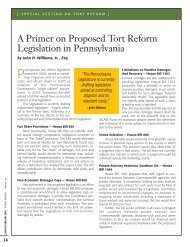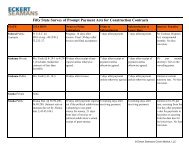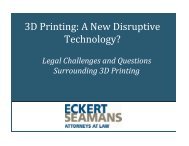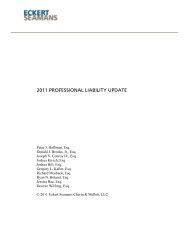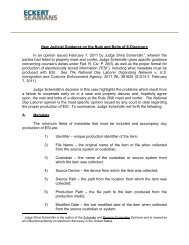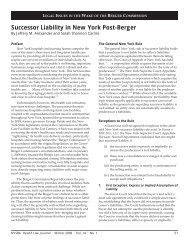testimony, Defendant presented his own expert witnesses, who testified that Defendant’streatment of Decedent did not fall below the standard of care.Likewise, Plaintiff relied on the testimony of her expert cardiologists on the issue ofcausation. Specifically, the expert cardiologists opined that when Defendant tested Decedent, hisleft coronary artery was already substantially occluded, and that occlusion would have beendetected by catheterization. Additionally, Plaintiff offered the expert testimony of a boardcertifiedforensic pathologist, who testified that the near-total occlusion of Decedent’s leftcoronary artery was a factual cause of his death. Importantly, Defendant’s own experts alsoagreed that catheterization would have detected the occlusion.After the close of evidence, the jury returned a verdict in favor of Defendant.Specifically, the jury indicated that although it found Defendant’s conduct to be below theapplicable standard of care, it also found that Defendant’s negligence was not a factual cause ofDecedent’s death. Following the denial of Plaintiff’s post-trial motions, Plaintiff appealed to theSuperior Court, seeking a new trial on the grounds that the jury’s conclusion as to causation wasagainst the weight of the evidence and was inconsistent with the medical testimony as tocausation that had been proffered at trial.Applying the increased risk of harm standard, the Superior Court found that the trial courtabused its discretion by refusing to grant Plaintiff’s motion for a new trial. Specifically, theCourt noted that, under the increased risk of harm standard, “the plaintiff must introducesufficient evidence that the defendant’s conduct increased the risk of plaintiff’s harm.” SeeCarrozza v. Greenbaum, 866 A.2d 369, 380 (Pa. Super. Ct. 2004). Clarifying this standard, theCourt further held that:[O]nce the plaintiff introduces evidence that a defendantphysician’snegligent acts or omissions increased the risk of theharm ultimately sustained by the plaintiff, then the jury must begiven the task of balancing the probabilities and determining, by apreponderance of the evidence, whether the physician’s conductwas a substantial factor in bringing about the plaintiff’s harm.Applying this standard and considering the strength of Plaintiff’s expert testimony with regard tocausation (especially in relation to the weak expert testimony proffered by Defendant), theSuperior Court concluded that the jury’s verdict was “irrational” in light of the uncontradictedand uncontested evidence of causation presented by Plaintiff, and remanded the case for newtrial. See also Qeisi v. Patel, No. 02-8211, 2007 U.S. Dist. LEXIS 9895 (E.D. Pa. Feb. 9, 2007)(holding testimony of expert witness that nine-month delay in performance of mammogram wassufficient to establish that Defendant increased Plaintiff’s risk of harm of developing cancer forpurposes of stating prima facie case of negligence); Gannon v. United States, 571 F. Supp. 2d615 (E.D. Pa. 2007) (Federal Tort Claims Act case holding Plaintiffs failed to prove thatPlaintiff-husband’s cancer was caused by a vaccine contaminated with a virus that Plaintiffsalleged Defendant had negligently approved and further holding that: 1) under Pennsylvania lawPlaintiffs had to prove both general causation (i.e. that the vaccine could cause cancer inhumans) and specific causation (i.e. that it caused cancer in the Plaintiff); 2) they neededadmissible expert testimony in order to prove causation and, 3) Plaintiffs’ expert failed to meet48
the required burden because his opinion was inconsistent with recent biological andepidemiological evidence and he relied only on experiments with rodents).D. Informed Consent – Medical MalpracticeThe Pennsylvania Supreme Court has in the past several years revisited and upheld theintentional tort battery theory underlying the doctrine of informed consent. See Montgomery v.Bazaz-Sehgal, 798 A.2d 742 (Pa. 2002); Morgan v. MacPhail, 704 A.2d 617 (Pa. 1997); see alsoGouse v. Cassel, 615 A.2d 331 (Pa. 1992); Moure v. Raeuchle, 604 A.2d 1003 (Pa. 1992). Todate, the Supreme Court has declined to recognize a cause of action for negligent failure toobtain informed consent.However, the distinction is not always material. For instance, in Fitzpatrick v. Natter,961 A.2d 1229, n.13 (Pa. 2008), the Court wrote, “An informed consent action, of course, soundsin battery rather than in negligence. . . . Nevertheless, the distinction between a battery and anegligence tort is irrelevant to the evidentiary question of what sort of evidence is sufficient toestablish an element of the claim; logically, the principles governing the admissibility ofcircumstantial evidence and the weight it may be accorded apply regardless of the nature of thecase, and the parties do not argue otherwise.”1. General RuleUnder current Pennsylvania law, a physician is required to obtain consent from hispatient concerning any non-emergency procedure enumerated in the MCARE Act, 40 Pa. Cons.Stat. § 1303.504. In order to constitute a valid consent, the patient must be informed of thematerial risks of the procedure prior to surgery. Absent informed consent, the physician may beheld liable to a plaintiff, under a theory of battery, for injuries arising from the undisclosed risk.See Gray v. Grunnagle, 223 A.2d 663 (Pa. 1966); see also Cooper v. Roberts, 286 A.2d 647 (Pa.Super. Ct. 1971).2. Expert Testimony RequiredPennsylvania courts place the burden upon the plaintiff to establish through experttestimony the existence of all risks of the chosen treatment, alternative methods of treatment andrisks of alternatives as well as causation. See, e.g., Hartenstine v. Daneshdoost, NO: 2005-C-2059V, 2008 Pa. Dist. & Cnty. Dec. LEXIS 60 (Lehigh Cty. Ct. Com. Pl. January 16, 2008). InFesta v. Greenberg, 511 A.2d 1371 (Pa. Super. Ct. 1986), appeal denied, 527 A.2d 541 (Pa.1987), the court specifically held that expert testimony is required to establish the followingthree elements:a. The existence of risks in the specific medical procedure;b. The existence of alternative methods of treatment; andc. The attending risks of such alternatives.49
- Page 3 and 4: EMTALA CASES ......................
- Page 5: Filing an Affidavit of Non-Involvem
- Page 8 and 9: II.PROFESSIONAL LIABILITY - AN OVER
- Page 10 and 11: The Superior Court reversed the tri
- Page 12 and 13: to a third party pursuant to the st
- Page 14 and 15: After approximately five months, De
- Page 16 and 17: learned the day after the surgery t
- Page 18 and 19: conduct to the delay in colon cance
- Page 20 and 21: court admitted the expert’s testi
- Page 22 and 23: (b)(c)other reasonable causes, incl
- Page 24 and 25: corroborated his testimony. The cou
- Page 26 and 27: husband’s estate. Plaintiff alleg
- Page 28 and 29: Other notable federal cases arising
- Page 30 and 31: The Superior Court found that in re
- Page 32 and 33: § 1303.512(b). The court, however,
- Page 34 and 35: In Neidig v. United States, No. 07-
- Page 36 and 37: Additionally, the Supreme Court not
- Page 38 and 39: were not indicated for her conditio
- Page 40 and 41: surgeon is the same as it would be
- Page 42 and 43: It should be noted that the Superio
- Page 44 and 45: Finally, the court held that the tr
- Page 46 and 47: The Supreme Court of Pennsylvania r
- Page 48 and 49: nurses deviating from applicable st
- Page 50 and 51: certainty, the court reviews expert
- Page 52 and 53: Under Pennsylvania law, the Court n
- Page 56 and 57: Following Cooper v. Roberts, 286 A.
- Page 58 and 59: Plaintiff developed chronic diarrhe
- Page 60 and 61: where payment is made by Medicaid w
- Page 62 and 63: accomplished. In Valles v. Albert E
- Page 64 and 65: In 1980, the Pennsylvania Superior
- Page 66 and 67: Plaintiff had a routine monitoring
- Page 68 and 69: Plaintiff’s Contract ClaimsThe Co
- Page 70 and 71: is a failure to report changes in a
- Page 72 and 73: unit to assure post-surgical patien
- Page 74 and 75: sliced his wrist and arm with a raz
- Page 76 and 77: licensed professionals for whom the
- Page 78 and 79: (c)Limitations of Corporate Neglige
- Page 80 and 81: Even more recently, our Superior Co
- Page 82 and 83: (a)HMO IssuesIn McClellan v. Health
- Page 84 and 85: affidavit submitted by Defendants o
- Page 86 and 87: treatments while at VA’s faciliti
- Page 88 and 89: [s]ubstantively, we believe that a
- Page 90 and 91: The party claiming the benefit of t
- Page 92 and 93: deprive (him) of civil rights guara
- Page 94 and 95: found that the District Court was w
- Page 96 and 97: With respect to fraudulent concealm
- Page 98 and 99: would be applied in situations wher
- Page 100 and 101: they had not raised them in the cou
- Page 102 and 103: (a)Informed ConsentUnder MCARE, a p
- Page 104 and 105:
civil enforcement provisions and ma
- Page 106 and 107:
MCARE also changes the manner in wh
- Page 108 and 109:
whose death, in 2005, was allegedly
- Page 110 and 111:
vicariously liable if the plaintiff
- Page 112 and 113:
health center or its equivalent or
- Page 114 and 115:
In Pennsylvania Medical Society, th
- Page 116 and 117:
to any professional who is alleged
- Page 118 and 119:
Since the 2005 amendments, there ha
- Page 120 and 121:
ule, but who intentionally ignores
- Page 122 and 123:
the original Complaint was delivere
- Page 124 and 125:
foreclose all challenges against th
- Page 126 and 127:
number of boxes), which was support
- Page 128 and 129:
questions of professional judgment
- Page 130 and 131:
deviated from any professional stan
- Page 132 and 133:
The Third Circuit affirmed the Dist
- Page 134 and 135:
claims and cross-claims remain agai
- Page 136 and 137:
By an Amendatory Order dated March
- Page 138 and 139:
The court acknowledged that there i
- Page 140 and 141:
apply and that the trial court misa
- Page 142 and 143:
Barbados had enough litigation-spec
- Page 144 and 145:
E. Preemption of Vaccine Design Def
- Page 146 and 147:
2. Pa. R. Civ. Pro. 1036.1 - Reinst
- Page 148 and 149:
Barrick, at *34-35.Furthermore, the
- Page 150 and 151:
(b) the utility of the defendant’
- Page 152 and 153:
2006). In this case, Plaintiffs bro
- Page 154 and 155:
B. Elements of a Cause of Action fo
- Page 156 and 157:
decision in Muhammad precluded Mr.
- Page 158 and 159:
considered speculative “only if t
- Page 160 and 161:
underlying cause of action involved
- Page 162 and 163:
In Capital Care Corp., the Superior
- Page 164 and 165:
The court found, however, to state
- Page 166 and 167:
of reasonable diligence. The standa
- Page 168 and 169:
not be set aside. On July 7, 2005,
- Page 170 and 171:
complete bar to recovery. Since a l
- Page 172 and 173:
On appeal, Plaintiffs claimed that
- Page 174 and 175:
In Liggon-Redding, 659 F.3d at 265,
- Page 176 and 177:
elieved of those minimum standards
- Page 178 and 179:
elevant to the proceedings, the com
- Page 180 and 181:
establish professional misconduct b
- Page 182 and 183:
Upholding the Superior Court’s Or
- Page 184 and 185:
Id.Rejecting revocation and suspens
- Page 186 and 187:
order as a sanction under Rule 4019
- Page 188:
{1009912]182




